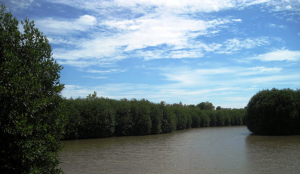Newsroom :: News :: MFF/FAO joint report; New low-cost mechanism for investing in mangrove protection and restoration
MFF/FAO joint report; New low-cost mechanism for investing in mangrove protection and restoration
Location: Bangkok, Thailand. 16th Dec 2016
Under the mechanism, mangrove mapping and monitoring are implemented using low-cost tools such as GPS units, smartphones, and free software and online platforms. Carbon stocks are estimated using two simple parameters – plot latitude and standing mean basal area – thus reducing field time and equipment costs. The majority of the tasks can be undertaken by local communities after initial training by mangrove experts. The mechanism clearly identifies involved parties and provides step-by-step instructions on project development, implementation and financing.
By reducing the costs of mangrove monitoring and carbon estimation, the mechanism allows for the protection and restoration of smaller areas of mangroves that are currently priced out of international carbon initiatives. It is designed to be used by private and public sector investors throughout Asia. By providing a simple, standardised yet flexible methodology, the mechanism has the potential to significantly increase investments in mangrove protection and restoration.
The mechanism was designed over a period of two years, with contributions from international mangrove experts, government agencies and academia. It was informed by visits to mangrove sites in Pakistan, Thailand and Vietnam, which included field-testing and extensive consultations with mangrove communities and local governments. The carbon estimation component was designed in collaboration with Yale University and will be published in PLOS ONE journal in the coming months.
With SIDA as a donor, and IUCN as a resource partner, the ‘Income for Coastal Communities for Mangrove Protection’ project was implemented by the FAO Regional Office for Asia and the Pacific Office (RAP), within the framework of the MFF initiative. Technical assistance was provided by the USAID Lowering Emissions in Asia’s Forests (LEAF) Program and the UN-REDD Programme.
The new mechanism is presented as a series of four publications that are now available for download from the MFF and ICEM website. The four reports, which are designed to be used collectively to guide the establishment of a sustainable financing for mangrove protection are:
- ‘Financing for mangrove protection with emphasis on Pakistan, Thailand and Viet Nam’
- ‘Mangrove-related policy and institutional frameworks in Pakistan, Thailand and Viet Nam’
- ‘Mangrove carbon estimator and monitoring guide’
- ‘Incentive allocation for mangrove protection’

Integrated mangrove-shrimp farming, Ca Mau, Viet Nam © IUCN